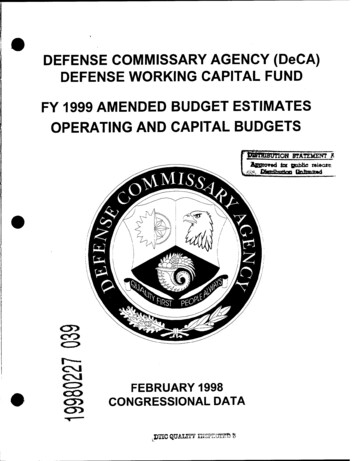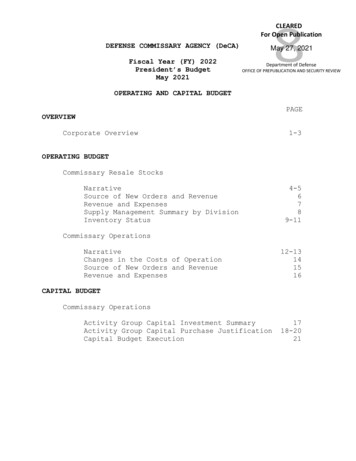
Transcription
DEFENSE COMMISSARY AGENCY (DeCA)DEFENSE WORKING CAPITAL FUNDFY 1999 AMENDED BUDGET ESTIMATESOPERATING AND CAPITAL BUDGETS«Wii*«g»fotfMÜJftiTIOS STATEMENT'SÄBBtored tat pibfie reiea* Dfcwrihntkio Uniu&itsdFEBRUARY 1998CONGRESSIONAL DATADflC QUALTTT m ?EöTB?5 B
DEFENSE COMMISSARY AGENCY (DeCA)DEFENSE WORKING CAPITAL FUNDFY 1999 AMENDED BUDGET ESTIMATESOPERATING AND CAPITAL BUDGETSPAGEOVERVIEWOperating and Capital BudgetsWorkload AssumptionsProductivity AssumptionsWorkload Measure1 -22-44-66-7OPERATING BUDGETCommissary Resale Stocks:NarrativeRevenue and ExpensesSource of RevenueChange in OperationsMaterial Inventory DataSupply Management Summary8-1011121314-1617-19Commissary Operations:NarrativeRevenue and ExpensesSource of RevenueChange in Operations20 -23242526CAPITAL BUDGETCapital Investment SummaryCapital Investment JustificationCapital Budget ExecutionLDH0272829-30QÜALCTY mSEECTED S
DEFENSE COMMISSARY AGENCY - CORPORATE OVERVIEWDeCA DEFENSE WORKING CAPITAL FUNDCOMMISSARY RESALE STOCKS AND COMMISSARY OPERATIONSThe Defense Commissary Agency (DeCA) provides a valuable non-paycompensation by operating military commissaries worldwide. Commissaries sell foodand household related items to active and reserve members of the MilitaryDepartments, their families, retirees, and other authorized patrons. Commissaries sellproduct at acquisition cost, resulting in patrons receiving a direct savings of at least 25percent off the typical market basket. This savings is an integral non-pay component ofthe total military lifetime compensation package and is instrumental in recruiting andretaining military members, for fostering a sense of community, and for maintaining apositive sense of quality of life, especially in overseas communities and remotelocations. Military members have embraced this valuable contribution to their lifetimetotal compensation package and rank the commissary as their number one non-paycompensation in importance.DeCA consists of a headquarters and field operating activities, located at FortLee, Virginia. There are 4 region offices, 37 zones, 298 commissaries, and 11 NavyExchange Marts (NEXMARTs) on military installations worldwide. DeCA employs over18,000 personnel, has annual sales of 5 billion with annual operating budget ofapproximately 1 billion.Appropriated funding for Commissary Operations will be devolved to the MilitaryServices effective October 1, 1998. Devolvement means that appropriated funding forDeCA operations will be provided by the Military Services as a reimbursable revenue toDeCA In FY 1999, this appropriated revenue from Military Services will be 983.9million- 338 4 million from the Army; 302.1 million from the Air Force; 256.8 millionfrom the Navy and 86.6 million from the Marine Corps. Allocation of this appropriatedfunding support from the Services is based on the percentage of total activity dutypersonnel and military retirees by Service. Devolvement will provide a better methodfor the Military Services to be more involved in decisions affecting commissaryoperations that impact the level of resources required to sustain the benefit. Thisshould benefit the patrons by providing a more direct link between the commissarycustomer requirements and the level of appropriated funds required to achieve results.I. OPERATING AND CAPITAL BUDGETSDeCA financially manages two activities within its Defense Working CapitalFund: Commissary Resale Stocks and Commissary Operations. Beginning in FY 1999,DeCA will be responsible for its own revolving fund cash management within theDefense Working Capital Funds. The appropriation request for FY 1999 of 63.7million will provide a single revolving fund cash account for DeCA's Resale Stocks andCommissary Operations activity groups in order to maintain the minimum cash balancenecessary to meet normal fluctuations in disbursements.1
a. Commissary Resale Stocks finances the purchase of inventory for resale toauthorized patrons. Authorized patrons are unlike the typical DoD customer, which isnormally a government entity financed by an appropriation. The DeCA customer is thecash paying commissary patron. Products offered by commissaries include groceries,meat, poultry, fruits, vegetables, dairy products, and household products. Commissaryitems are sold at cost plus a 5 percent surcharge. There is no requirement forappropriated fund support. Projected sales for FY 1999 are 5.0 billion.b. Commissary Operations finances operating costs for resale stores, agencyand region headquarters, and support services. Specific costs include civilian andmilitary labor, labor contracts, travel, transportation of commissary goods overseas,indirect and other base support. Beginning in FY 1999, the primary revenue source forthis activity group is appropriated fund reimbursement from the Military Departments.Commissary Operations also receives additional revenues (about 40 million) fromprocessing manufacturers' coupons, handling fees for tobacco products andreimbursements for other support. Commissary Operations unit cost goal is based onsales as the output.II. WORKLOAD ASSUMPTIONSThe Sales forecast for resale items for FY 1999 is 5.0 billion. Sales are theprimary factor in determining DeCA's workload; however, there are many other factorsthat influence workload; e.g., authorized patrons, number and location of commissaries,operating hours and days, distribution systems, information management systems,facility condition, and regulatory and statutory requirements.a.DeCA's total authorized patron baseline is approximately nine millionpersonnel.DeCA's customers include active duty military members, reservecomponent members, retired personnel, and their families; government departments oragencies and DoD civilians in overseas areas; and official organizations and activitiesof the military departments.b. DeCA plans to begin FY 1999 with 295 commissaries. There are also 11NEXMARTs, which combine commissary and exchange operations at small locationsoverseas. The Navy Exchange Command (NEXCOM) manages these stores, butDeCA provides the resale inventory and reimburses NEXCOM for total costs ofcommissary operations.c. Commissary operating hours and days are determined by sales, patrondemographics, and local installation needs. Commissaries are open an average of 48hours a week.Personnel strength is determined through application of workloadbased engineered staffing standards.
d. DeCA operates 12 central distribution centers (CDC) to support inventoryrequirements: 2 each in Germany, United Kingdom, Korea and Alaska; and 1 each inJapan, Okinawa, Panama, and Guam.DeCA employs a total of 16,977 personnel (full-time equivalents (FTEs))beginning in FY 1999 (16,965 civilians and 12 military). FTEs have decreased byapproximately 28 percent since FY 1992 when there were 23,398 FTEs.MILITARY AND CIVILIANFULL-TIME EQUIVALENTS TREND2500028% DECREASE2000015000FY1992FY1999I Full-time EquivalentsThe DeCA Overseas Ordering and Receiving System (DOORS), FrequentDelivery System (FDS) and other initiatives have enabled DeCA to reduce theinvestment in inventory on hand and intransit from 549.5 million at the end of FY 1991to 322 million at the end of FY 1999. Inventory on order and intransit representsadministrative and production lead time and is often referred to as order ship time(OST) or pipeline. The projected OST for FY 1998 and FY 1999 for all DeCAcommissaries is less than 2 days of supply compared to 15 days of supply experiencedin FY 1992. This is over a 90 percent reduction. DeCA will also reduce the on-handinventory level by over 30 percent from the level maintained by the Military Departmentsat the end of FY 1991 as noted in the following chart:Inventory On-hand IN MILLIONS30.6% INVENTORY REDUCTION 307.0FY 1999FY 1992I Inventory On-hand
An integral component of DeCA operations is information systems. During thisbudget, DeCA will continue to modernize its point of sales (POS-M) equipment and itsbusiness system, Defense Commissary Information System (DCIS).a. POS-M is required to replace several legacy systems transferred from theMilitary Departments. The POS-M system includes price scanning and upgradedcheckout counters to improve through-put at checkout. With the deployment of POS-M,DeCA is also pursuing: electronic shelf labels to assist with price changes; electronicsurveillance; and Electronic Benefits Transfer for food stamps.b. DCIS will interface with POS-M and will provide management informationsystem (MIS) data on inventory management, merchandise buying, labor forecastingand scheduling, labor time and attendance, direct store delivery of merchandise,computer assisted ordering, business mail, funds management, and a decision supportsystem.III. PRODUCTIVITY ASSUMPTIONSDeCA continues to stay on the leading edge of reinventing government byidentifying and implementing more cost-effective business practices. Based on past andplanned performance, DeCA was designated a pilot agency for the GovernmentPerformance and Results Act (GPRA), received three "Hammer Awards" and is one ofnine Performance Based Organizations in the federal government. DeCA was alsonominated for the Presidential Quality Award during FY 1998.a. Since consolidating the four separate commissary systems, DeCA reduced itsoperating costs from more than 1.2 billion in FY 1993 to less than 975 million in FY1997. Additional savings of over 40 million for FY 1998 and FY 1999, due tostreamlining and consolidation plans, will partially offset the effects of inflation and otherprice growth, including civilian pay raises.b. DeCA streamlined functions above store level by reducing the number ofregion headquarters from seven to four in FY 1998. In addition, a reorganizationreduced operating costs for the DeCA Headquarters and the field operating activitiesstaffs. This effort will reduce overhead costs by 5.7 million in FY 1998 and anadditional 1.2 million in FY 1999.c. Staffing in commissaries was reduced by consolidating management supportcenters (accounting functions located in commissaries) into six centralized AccountsControl Sections (ACS). This consolidation, coupled with other store operatingefficiencies and reapplication of staffing standards, will reduce operating costs by 11.3million and 298 workyears in FY 1998.
d. DeCA continues to reduce operating costs by outsourcing selective functionsand services under OMB Circular A-76 procedures. DeCA began FY 1998 with 195 A76 contracts in effect for shelf stocking, custodial and warehousing functions. Sevennew A-76 studies are planned during FY 1998. DeCA also uses services from DefenseLogistics Agency, Defense Finance and Accounting Service and the MilitaryDepartments for support in areas associated with personnel servicing, procurement offresh fruits and vegetables, accounting, systems development, construction and basesupport.Joint ventures with the exchange systems are also producing economies andincreasing convenience for patrons. For example, patrons were extremely pleased withthe Port Hueneme, CA combined commissary and exchange complex that opened inFY 1997. DeCA and the Army and Air Force Exchange System (AAFES) areconstructing side-by-side facilities under one roof at Aviano, Italy; Elmendorf, AK; FortBuchanan, Puerto Rico; and Fort Bragg, NC. DeCA and the Navy Exchange Systemalso have commissary and exchange joint construction projects scheduled for Naples,Italy and North Island, CA in FY 1998.OCONUS and remote locations cost more per dollar of sales than CONUSlocations, but are vital for military members and their families because adequatealternative shopping is not available. OCONUS and remote locations use about 45percent of DeCA support financed with appropriated funds to produce 23 percent ofsales, demonstrating higher costs than those in CONUS. These commissaries aremore expensive because operating and support costs in foreign and remote locationsare higher, and because many locations service small-to-medium military populationswith smaller sales and higher fixed costs. Additionally, there are significant supportcosts incurred in providing U.S. food products and household items overseas, e.g.,transportation which is about 166.6 million in FY 1999. Regardless of these costconsiderations, overall cost efficiency and effectiveness is improved because DeCA'sinfrastructure provides economies that are not achievable as separate activities withinthe Military Departments. The commissary system is critical in supporting militarypopulations overseas and is essential to their quality of life. Furthermore, commissariesare instrumental in minimizing cost of living allowances (COLA) overseas by providinglow-cost groceries.DeCA continuously strives to improve customer service, while developing morecost effective business practices. For example, DeCA is implementing:a. In-store banking services, and debit and credit card transaction processing.b. Home Meal Replacement program, consisting of precooked and prepackagedside dishes and entrees, a growing trend in the commercial sector. Plans are toimplement this program at 30 commissaries during FY 1998 and 60 additionalcommissaries in FY 1999, with no increase in appropriated funding support.
c. Centralized category management plans to provide better stock assortmentand minimize not-in-stock conditions. By FY 1999, 118 category plans will becompleted. DeCA is centrally managing store resets which result in better execution ofcategory management plans for Industry and DeCA.d.Personnel improvements using the automated Telephone ApplicationProcessing System (TAPS) to receive, evaluate and rank applicants for cashier, storeworker, and meatcutter positions. This initiative reduced the lag-time for hiring of theseposition from 75 days to 8 days to notify and 20 days for employee to enter on duty,without additional costs.DeCA was nominated to be a Performance Based Organization (PBO). PBOsare part of the National Performance Review, sponsored by the White House andmanaged by the Vice President. DeCA will represent change in the way the federalgovernment works. That includes adopting some characteristics of private-sectorcompanies and obtaining special regulatory and administrative waivers so the agencycan operate more efficiently.Productivity in DeCA is best illustrated by comparing workload data betweencommercial supermarkets and the commissary system, which clearly demonstrates thatcommissaries are cost effective and highly used by their patrons.(Source for Supermarket Data: Progressive Grocer, April 1997)WORKLOAD MEASUREAverage Weekly Sales per StoreWeekly Sales Per Square FootAverage Weekly Sales per Employee (Storelevel)Average Weekly Sales per Checkout(CONUS only for comparison)COMMISSARY 327,000 17.21 6,412SUPERMARKET 207,603 7.65 3,300 32,712 23,902
FY1997Savings/Efficiencies/ClosuresCommissary Operations ( M)Workload IndicatorsCommissary (begin year)Annual Sales ( M)Resale Inventory ( M)Performance Indicators(Goals for FY97-FY99)Inventory TurnsIn-Stock RateCustomer SavingsEnd Strenath and WorkyearsCivilian End StrengthMilitary End StrengthCivilian WorkyearsMilitary 5%18,9831616,8021618,7281216,9651218,6891216,91012
DEFENSE COMMISSARY AGENCYDeCA DEFENSE WORKING CAPITAL FUNDCOMMISSARY RESALE STOCKSFUNCTIONAL DESCRIPTIONResale Stocks finances inventory sold by the commissary system. Productsstocked include groceries, meat, poultry, fruits, vegetables, dairy products, and householdgoods. Revenue from sales at cost is used to purchase inventory for resale. Therefore,it is self-sufficient requiring no appropriated fund support.A five percent surcharge is applied to sales at the check out counter. Thissurcharge is required by law and finances certain commissary operation and constructioncosts. Revenue from this surcharge is accounted for in the Surcharge Collections, Salesof Commissary Stores, Defense account.DeCA provides a valuable non-pay compensation to its primary authorizedcommissary patrons: military members and their families, reserve forces personnel,retired personnel and annuitants. Other authorized sales are made to governmentcivilian overseas, troop issue subsistence, nonappropriated fund activities, U.S. StateDepartment activities, and others. Recent customer surveys indicate that the commissarybenefit has replaced medical care as the most valued quality of life benefit.BUDGET HIGHLIGHTSRevenue consists entirely of cash, charge, and coupon sales. Cash and couponsales to active duty and reserve military members and their families, retirees, foreignentities and nonappropriated funds represent over 99 percent of total revenue. Chargesales includes Army troop issue subsistence, National Guard and other appropriatedfund sales.The unit cost goal for this activity group is 1.00 per dollar of sales because resaleproducts are sold at acquisition cost. Therefore, the Net Operating Result (NOR) for thebudget years is planned to be zero.CHANGES IN OPERATIONSSales forecasts have been changed to reflect the policy of selling consignedtobacco products at Exchange prices effective 1 November 1996. Tobacco sales for FY1998 and 1999 are projected to be over 100 million lower than FY 1996. In addition,customer count indicates that non-tobacco sales have decreased due to the tobaccoprice increase.8
The DeCA Overseas Ordering and Receiving System (DOORS), FrequentDelivery System (FDS), and other initiatives have enabled DeCA to reduce theinvestment in inventory on hand and intransit to 322.0 million for FY 1998 and FY 1999.Comparing this inventory level with the 549.5 million maintained by the MilitaryDepartments at the end of FY 1991 provides an overall inventory reduction of 227.5million, 41.4 percent. The significance of this achievement is further illustrated bycomparing the following components of the acquisition process in terms of days of supply.a. Inventory on hand includes operating and safety levels. These levels arenormally expressed in days of supply based on average daily sales. Average daily salesare projected to be 13.9 million for FY 1998 and FY 1999 with 23 days of supply. Incomparison, average daily sales for FY 1991 were 16.7 million with 36 days of supply, a36 percent reduction in terms of days of supply.b. Inventory on order and intransit represents administrative and production leadtime and is often referred to as order/ship time (OST) or pipeline. The projected OST forFY 1998 and FY 1999 is less than 2 days of supply compared to the 15 days of supplyexperienced in FY 1991, a reduction of over 90 percent.Innovations in the acquisition process, such as replacing cumbersome supplybulletins and blanket delivery orders/purchase agreements with resale orderingagreements, resulted in a reduction of contracts used for buying resale items. Less than1,000 contracts exist now, where there used to be more than 3,300.Centralizing key aspects of commissary management under the Field OperatingActivities was accomplished to reduce costs both to the agency and the food industry.The following business units have been instrumental in the success of the agency's reengineering efforts and in achieving overall cost reductions.a. The Contract Management Business Unit centrally orders supplies andequipment and non-brand name subsistence and prepares service contracts. It developsstandards for items and services through market research, establishes contracts tosupport commissaries, regions, and headquarters, and manages property accountability.b. The Marketing Business Unit performs category management, whereby allmerchandising reviews for new items are centrally accomplished and conducts categoryreviews for national brand name items. Instead of just buying the lowest priced items,buyers seek the largest savings for the highest volume sellers in a category. It alsodevelops monthly, holiday, and seasonal promotional sales to include quarterly truckloadsales.These efforts to centralize ordering and streamline acquisitions have paid off with asignificant increase in patron savings. The FY 1996 Market Basket Comparison Study,done primarily to determine differences between commissary and private-sector9
supermarket prices, found that average savings for shoppers in the contiguous UnitedStates is 29.7 percent, 6.3 percent greater savings than the last study done in FY 1992.Workload IndicatorsNumber Commissaries (begin year)Annual Revenue ( M)Ending Inventory On-Hand ( 07.0307.0Performance MeasuresFY97FY98FY99Inventory Turns161616In-Stock Rate97%97%97%Financial IndicatorsFY99FY97FY985,177.45,000.05,000.0Net Operating Results ( M)(50.4)00Accum Operating Results ( M)(178.7)(178.7)(178.7)Unit Cost (Per of Sales)1.00991.00001.0000Cost of Goods Sold ( M)10
DEFENSE BUSINESS OPERATIONS FUNDDEFENSE COMMISSARY AGENCY/COMMISSARY RESALE STOCKSREVENUE AND EXPENSES(Dollars in Millions)FY1997FY1998FY1999RevenueGross SalesOperationsCapital SurchargeDepreciation excluding Major ConstructionMajor Construction DepreciationOther IncomeRefunds/Discounts (-)Total .00.00.05,000.0ExpensesCost of Material Sold from 00.00.00.00.00.0(50.4)0.00.00.00.00.0Salaries and Wages:Military Personnel Compensation & BenefitsCivilian Personnel Compensation & BenefitsTravel & Transportation of PersonnelMaterials & Supplies (For internal Operations)EquipmentOther Purchases from Revolving FundsTransportation of ThingsDepreciation - CapitalPrinting and ReproductionAdvisory and Assistance ServicesRent, Communication, Utilities, & Misc. ChargesOther Purchased ServicesBad DebtsOther ExpensesTotal ExpensesOperating ResultLess Capital Surcharge ReservationPlus Appropriations Affecting NOR/AOROther Changes Affecting NORNet Operating ResultOther Changes Affecting AOR(178.7)Accumulated Operating Result(178.7)(178.7)Exhibit Fund-14 Revenue and ExpensesFebruary 199811
BUSINESS AREA ANALYSISDEFENSE COMMISSARY AGENCY/COMMISSARY RESALE STOCKSSOURCE OF REVENUE(Dollars in 8.00.00.48.78.218.00.00.4b. Orders from other Fund Activity GroupDWWCF0.00.00.0c. Total DoD35.335.335.3d. Other Orders:Other Federal AgenciesTrust FundNon Federal AgenciesForeign Military 0.0Total New Orders5,126.75,000.05,000.00.00.00.03. Total Gross Orders5,126.75,000.05,000.04. Funded Carry-over0.00.00.05. Total Gross Sales5,126.75,000.05,000.01. New Ordersa. Orders from DoD Components:ArmyNavyAir ForceMarine CorpsOther2. Carry-In OrdersExhibit Fund-11 Source of RevenueFebruary 199812
Defense Commissary Agency/Resale StocksChanges in the Costs of OperationFebruary 1998(Dollars in Millions)Expenses1.FY1997 Actual Costs5,177.42.FY 1998 PB Estimate5,000.03.Program Changes4.Pricing Changes5.Savings/Efficiencies6.Adjusted FY 1998 Estimate7.Pricing Adjustments8.Savings/Other Efficiencies9.Program Changes5,000.05,000.010. FY 1999 Current EstimateExhibit Fund-2 Changes in the Costs of OperationFebruary 199813
February 1998DIVISIONFY 1997 BUDGETDEFENSE COMMISSARY AGENCY (DeCA) SUPPLY MANAGEMENTINVENTORY STATUS1.2.3.4.5.6.7.INVENTORY BOPBOP INVENTORY ADJUSTMENTSa. RECLASSIFICATION CHANGE (Memo)b. PRICE CHANGE AMOUNT (Memo)c. INVENTORY RECLASSIFIED ANDREPRICEDRECEIPTS AT STANDARDSALES AT STANDARDINVENTORY ADJUSTMENTSa. CAPITALIZATIONS or (-)b. RETURNS FROM CUSTOMERS FORCREDIT c. RETURNS FROM CUSTOMERS WITHOUTCREDITd. RETURNS TO SUPPLIERS (-)e. TRANSFERS TO PROPERTY DISPOSAL (-)f. ISSUES/RECEIPTS WITHOUTREIMBURSEMENT or (-)g. OTHER (LIST/EXPLAIN)h. TOTAL ADJUSTMENTSINVENTORY EOPINVENTORY EOP, REVALUED (LAC,DISCOUNTED)a. ECONOMIC RETENTION (Memo)b. CONTINGENCY RETENTION (Memo)c. POTENTIAL DOD REUTILIZATION (Memo)INVENTORY ON ORDER EOP (Memo)NARRATIVE (Explanation of unusual CETIMEOTHERExhibit Fund-16 Material Inventory Data (Page 1 of 3)February 199814
FY1998 BUDGETDIVISIONFebruary 1998DEFENSE COMMISSARY AGENCY (DeCA) SUPPLY MANAGEMENTINVENTORY STATUS1.2.3.4.5.6.7.8.9.INVENTORY BOPBOP INVENTORY ADJUSTMENTSa. RECLASSIFICATION CHANGE (Memo)b. PRICE CHANGE AMOUNT (Memo)c. INVENTORY RECLASSIFIED ANDREPRICEDRECEIPTS AT STANDARDSALES AT STANDARDINVENTORY ADJUSTMENTSa. CAPITALIZATIONS or (-)b. RETURNS FROM CUSTOMERS FORCREDIT c. RETURNS FROM CUSTOMERS WITHOUTCREDITd. RETURNS TO SUPPLIERS (-)e. TRANSFERS TO PROPERTY DISPOSAL (-)f. ISSUES/RECEIPTS WITHOUTREIMBURSEMENT or (-)g. OTHER (LIST/EXPLAIN)h. TOTAL ADJUSTMENTSINVENTORY EOPINVENTORY EOP, REVALUED (LAC,DISCOUNTED)a. ECONOMIC RETENTION (Memo)b. CONTINGENCY RETENTION (Memo)c. POTENTIAL DOD REUTILIZATION (Memo)INVENTORY ON ORDER EOP (Memo)NARRATIVE (Explanation of unusual CETIMEOTHERExhibit Fund-16 Material Inventory Data (Page 2 of 3)February 199815
FY1999 BUDGETDIVISIONFebruary 1998DEFENSE COMMISSARY AGENCY (DeCA) SUPPLY MANAGEMENTINVENTORY STATUS1.2.3.4.5.6.7.8.9.INVENTORY BOPBOP INVENTORY ADJUSTMENTSa. RECLASSIFICATION CHANGE (Memo)b. PRICE CHANGE AMOUNT (Memo)c. INVENTORY RECLASSIFIED ANDREPRICEDRECEIPTS AT STANDARDSALES AT STANDARDINVENTORY ADJUSTMENTSa. CAPITALIZATIONS or (-)b. RETURNS FROM CUSTOMERS FORCREDIT c. RETURNS FROM CUSTOMERS WITHOUTCREDITd. RETURNS TO SUPPLIERS (-)e. TRANSFERS TO PROPERTY DISPOSAL (-)f. ISSUES/RECEIPTS WITHOUTREIMBURSEMENT or (-)g. OTHER (LIST/EXPLAIN)h. TOTAL ADJUSTMENTSINVENTORY EOPINVENTORY EOP, REVALUED (LAC,DISCOUNTED)a. ECONOMIC RETENTION (Memo)b. CONTINGENCY RETENTION (Memo)c. POTENTIAL DOD REUTILIZATION (Memo)INVENTORY ON ORDER EOP (Memo)NARRATIVE (Explanation of unusual CETIMEOTHERExhibit Fund-16 Material Inventory Data (Page 3 of 3)February 199816
1S 3S ra5tuS2DCSHJ;—7?S - sö 2 5«-5WS:nsS(9 '1 1( lsX1,1;1iI .; **S"ö.a«*9i,1j!!I!i1i.1111'1!s',w113iXm; :esHii!i11,1II;i!1!i1!1i1:i,1e m2OSoIr* e &eW»«SQu1j5§3ie 1,1i! «*3*;i111 ll111ei11 sc111Z1111inZUl-80i1ta.in «rt 11Otf it cv s2s ssEiCSHin S toesHin .c u"ioMeiCeootef*- 1O Ä2CS3 OWin:, 1o e ? e S cw00esro » a? JSCa,1«n111JJ ui*» sl D1/1IV»«11ie «wio )01o:!1i1*1i!i17!i11jö »] 1i !iii:iii:'iil1;:iI:Ii!i ; i1,i;:; :i,:'- 2s *5 es
ooo5 o 22 .!o3inui«IUi(9co1022OeZ2*I V)SeeoOQ* 'S *CMJ5 s -S3 Oi s2SoI'DIOI Alv 011 «to' Ii:ii 5I«AOIo;18I
ias;i o1IS lf !ic2E o .r oiSs1.1i' i!:i!''!i1i1'I !11:' i;111ll!ii i!inUli2UJ«IiXO5Zi'lii'To 1!«s» 1'1 ili1ig22 GETO2e«ACso5 1C3oooU)oQuU «»5e a«««s c » fu o 2.EooooooM" w* " 2 "1i1l;'LD1 eo oo:'! M*»Net«iw «o3 Oooo stomlidereatIoo »oZa 1QJ.V)IA o3 sI iI iOVl1ii'526 o\1!IBE ou Ii o1 o1- 00iUm« »., .oE. OesiuCmCOÜre * J? —c&iii,I'u5—», ov)ii 5t/1i2i11a1 i Oiii1;SI{,ii1jI'0)e:r19:j11—1 "*
DEFENSE COMMISSARY AGENCYDeCA DEFENSE WORKING CAPITAL FUNDCOMMISSARY OPERATIONSEUM T10JSIAL„D SJ3JRlPTLONThe Commissary Operations activity group finances operation of 298 resale stores, 11NEXMARTs, 37 zones, 4 region offices, field operating activities, headquarters, and relatedsupport services. Specific costs include civilian labor, contracts, travel, transportation ofcommissary goods overseas, indirect and other base support, and military personnel. Aspart of the lifetime military compensation package, these costs are financed byreimbursements from the Military Departments and are not charged to the military memberand their families.Commissaries sell products at acquisition cost to authorized patrons, while maintaininghigh standards for quality, facilities, products, and services. The reimbursements receivedfrom the Military Departments' appropriations is an integral part of this process and is thefoundation that allows military members and their families to receive a direct savings of atleast 25 percent below the typical market basket. The commissary has become an integralsegment of the entitlement and lifetime military compensation package used in recruiting andretaining military members.BUDGET MGHLLGHTSAppropriated funding for Commissary Operations will be devolved to the Military Services,effective October 1, 1998. Devolvement means that appropriated funding for DeCAoperations will be provided by the Military Services as a reimbursable revenue to DeCA. InFY 1999, this appropriated revenue from Military Services will be 983.9 million: 338.4million from the Army; 302.1 million from the Air Force; 256.8 million from the Navy; and 86.6 million from the Marine Corps. Page 25 (Sources of Revenue) references the pages inthe Military Services' appropriated fund budget justification material that indicate the level ofsupport requested to finance DeCA's Revolving Fund costs of operation. Allocation of thisappropriated funding support from the Sen/ices is based on the percentage of total activityduty personnel and military retirees by Service. Devolvement will provide a better methodfor the Military Services to be more involved in decisions affecting commissary operationsthat impact the level of resources required to sustain the benefit. This should benefit thepatrons by providing a more direct link between the commissary customer requirements andthe level of appropriated funds required to achieve results.DeCA is fully committed to continuously working toward improving operations at all levels,while reducing appropriated fund support. This commitment has resulted in reducingoperating costs from more than 1.
new A-76 studies are planned during FY 1998. DeCA also uses services from Defense Logistics Agency, Defense Finance and Accounting Service and the Military Departments for support in areas associated with personnel servicing, procurement of fresh fruits and vegetables, accoun










